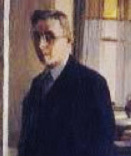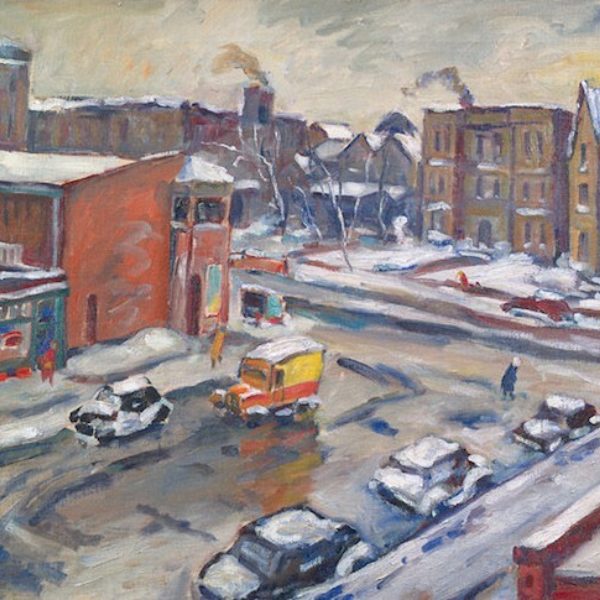
Tunis Ponsen
b. 1891, Wageningen, Holland - d. 1968, Chicago, IL
Tunis Ponsen, born in the town of Wageningen in The Netherlands in 1891, was the son of a house painter whose trade he learned as a boy. He manifested an early interest in the fine arts, copying a painting at the Rijksmuseum when he was 14. After a period of formal study with several artists, he was awarded a certificate enabling him to teach art at the elementary school level in 1908. By the time he was 18 both of his parents had died, and in the political and economic turmoil before World War I, Ponsen decided to emigrate to the United States. He settled in the western Michigan city of Muskegon, where there was a large Dutch community, by 1914. The following year his older sister settled with her husband in nearby Benton Harbor. Ponsen’s relationship with his sister was one of the most important in his life, and extended to her daughter Anjenita, with whom the unmarried and childless artist forged a close, almost parental connection.
Ponsen supported himself as a painter and decorator in Muskegon, while maintaining his interest in the fine arts. He studied drawing for a semester in 1917 at the School of the Art Institute of Chicago (SAIC) and after becoming a citizen and serving in the army, returned to Muskegon, where, in 1921, after exhibiting several paintings, he enrolled in night classes at the Hackley Gallery (now the Muskegon Museum of Art). Promised a solo exhibition at the gallery if his work merited it, he was rewarded in 1922 and 1923 with one-person exhibitions. Even after he left Muskegon permanently for Chicago in 1924, his work was shown frequently over the years at the Hackler Gallery, culminating in a large retrospective in 1994. His success in Muskegon, where he received many portrait commissions and sold many of his landscapes and still lifes, combined with the encouragement and support of his teachers persuaded him to pursue more professional education at the SAIC. He began his studies at a time when the pedagogy of the school was still very traditional, corresponding to Ponsen’s previous experiences. He was a meticulous craftsman, and adhered to a conventional, representational style for the most part. In addition to the old school instructors George Oberteuffer and Karl Buehr, Ponsen also studied with the visiting New York artist Leon Kroll in 1924. While Kroll may have introduced his students to some modernist ideas, however, his work was figural and already fairly conventional during the period he taught at the SAIC.
Ponsen worked primarily in a traditional manner, exhibited in many moderate venues, such as the Chicago Galleries Association, and was lauded by conservative critics like Eleanor Jewett. His skill as an artist and lack of rigidity, however, allowed him to bridge the gap between traditional and modern, to experiment early on with Precisionism and later with pure abstraction. Most of his work meets his self-proclaimed objective of painting well and painting what he saw. Like the Impressionists, Ponsen was interested throughout his career in the play of light, and in the effects of weather and the changing seasons. In Winter Streets, Chicago, Ponsen focused on the remains of a winter snowstorm, the slick streets, people bundled against the winds, and the gray skies punctuated by the bright colors in the shop window and delivery truck in the center of the composition. Ponsen’s emphasis on the low-rise buildings and everyday activities in a Chicago neighborhood—probably one of the South Side locations where he lived all of his life—corresponds to the glorification of small town life that characterized the art of the Depression era in the United States. Like most of his contemporaries, Ponsen was employed periodically on the government-supported art projects of the New Deal.
Ponsen enjoyed popularity as an artist, exhibiting frequently in the Art Institute of Chicago annuals, with the South Side Art Association, the All Illinois Society of the Fine Arts, and a number of other (mostly conservative) artists’ exhibition groups. He supported himself by holding classes in his studio, teaching part-time at the Chicago Academy of Fine Arts, and in the last decades of his life, teaching at several community arts centers where he had a devoted following of women students. He was a modest and retiring man, devoted to his sister and her family, a number of close artist-friends, and the students with whom he maintained warm and lasting relationships.
Susan Weininger
Reference
Weininger, Susan, et al. The Lost Paintings of Tunis Ponsen (1891–1968). Muskegon, MI: Muskegon Museum of Art, 1994.
Artist Image: Self Portrait / Tunis Ponsen. Copyright by the artist.
